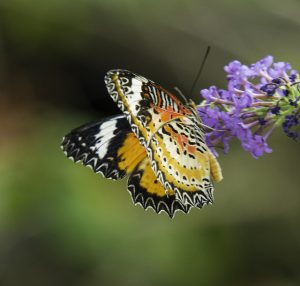
Emilie Snell-Rood studies butterflies to understand the factors that influence plasticity.
The ability of animals to vary their phenotypes, or physical expression of their genes, in different environments is a key element to survival in an ever-changing world.
Emilie Snell-Rood, PhD, of the University of Minnesota, is interested in why this phenomena of plasticity varies. Some animals’ phenotypes are relatively stable despite varying environmental pressures, while others display a wide range of behaviors.
Researchers have looked into how the costs of plasticity limit its variability. While many biologists expected that energetic costs should be adequate explanations for the limits to plasticity, only about 30 percent of studies that have looked for plasticity-related costs have found them.
With her model of butterflies, Snell-Rood has worked to understand why these researchers have come up with little results.
Snell-Rood hypothesized that the life history of an animal, or the timing of major developmental events like weaning, should be of vital importance in the constraints on plasticity, specifically on the type of plasticity involved in learning. Much of learning involves trial and error, which is costly – it requires time, energy, and exposure to potential predators while exploring the environment.
Additionally, behavioral flexibility requires an investment in developing brain tissue to accommodate this learning.
Because of these costs, animals that engage in this kind of learning must forgo reproduction until later in life.
To test the costs of learning, Snell-Rood used butterflies as a subject. Butterflies require developmental plasticity to explore their environments and optimize their food finding strategies. Over time, butterflies get more efficient at landing on the best host plants, using color and other visual cues to find the best food sources.
Studying butterfly families shows that families that are better learners have increased volume in the part of the brain associated with sensory integration. Furthermore, experimentally speeding up an organism’s life history leads to a decline in learning ability.
These results support a tradeoff between an organism’s developmental plasticity and life history. While this strategy is more costly in terms of investment in neural development and energy investment, it provides greater efficacy in adaptation to environment. However, further pressures from resource availability can also influence plasticity.
Looking to the butterfly model, Snell-Rood found that quality nutrition increases egg production as well as areas of the brain associated with plasticity.
Understanding factors that influence an animal’s plasticity is becoming increasingly important. Not only does it allow us to understand the role of plasticity in evolution up to this point, but it allows us to predict how organisms will adapt to novel and changing environments, especially those that are changing because of human influence. For the purposes of conservation, these predictions are vital.
 By Sarah Haurin
By Sarah Haurin

